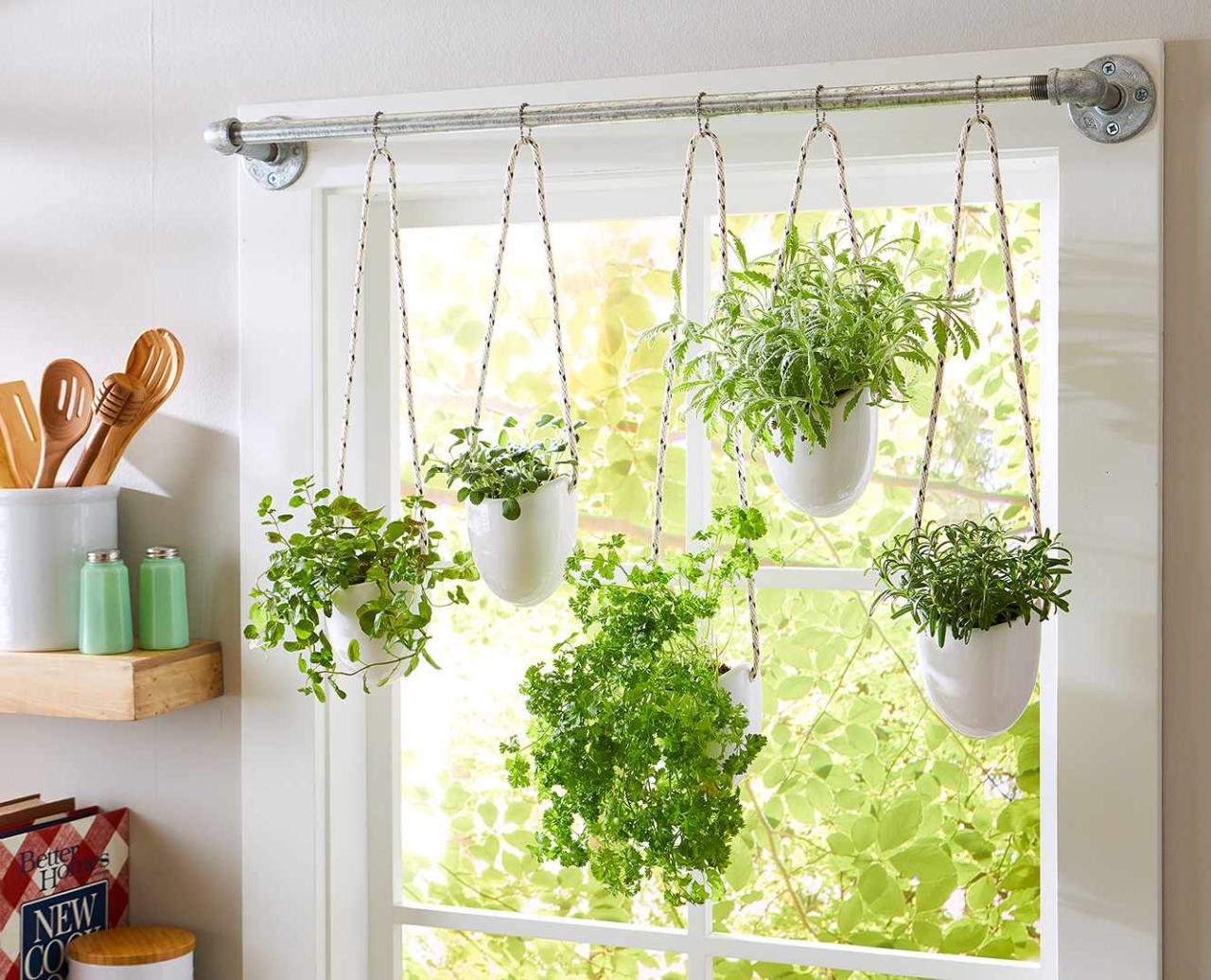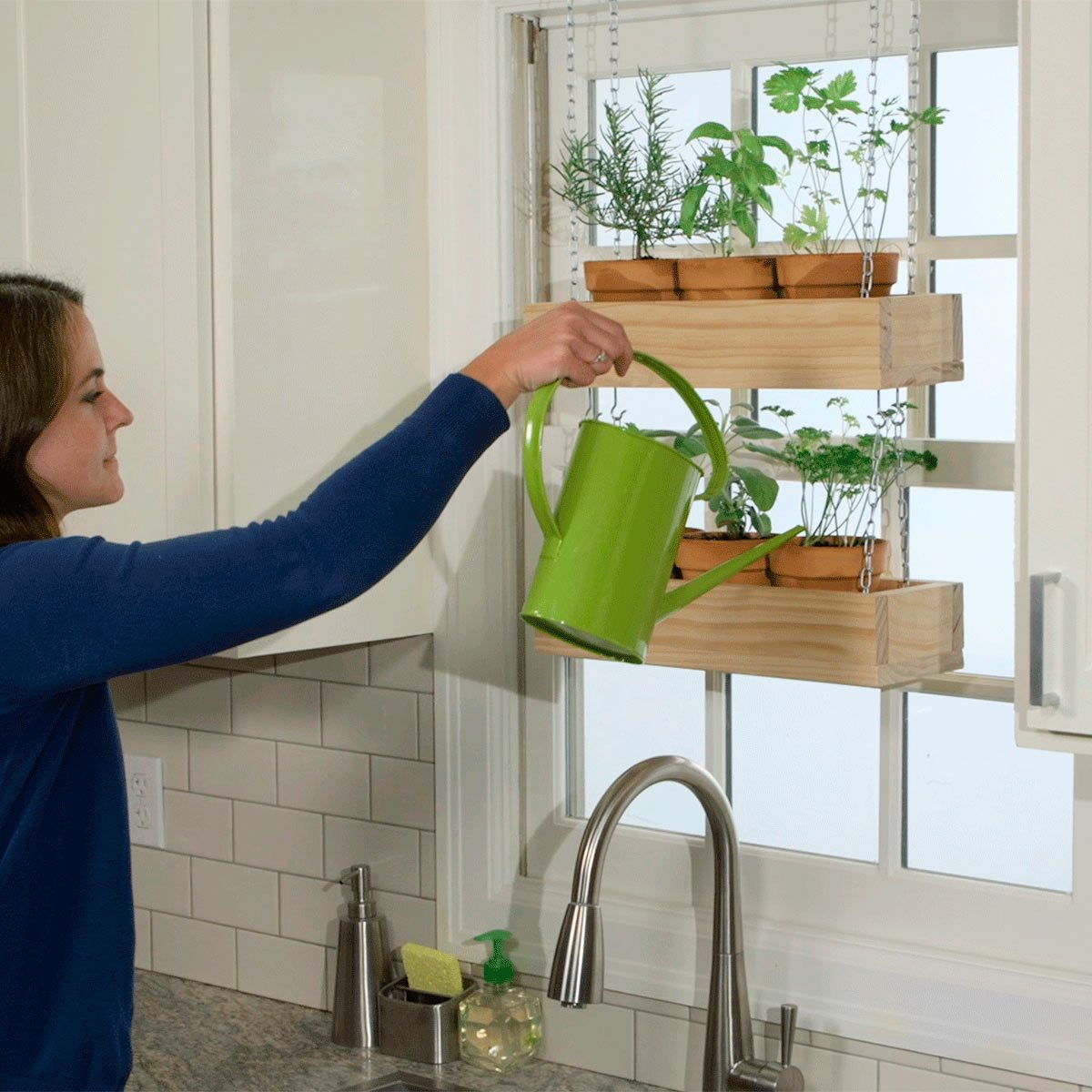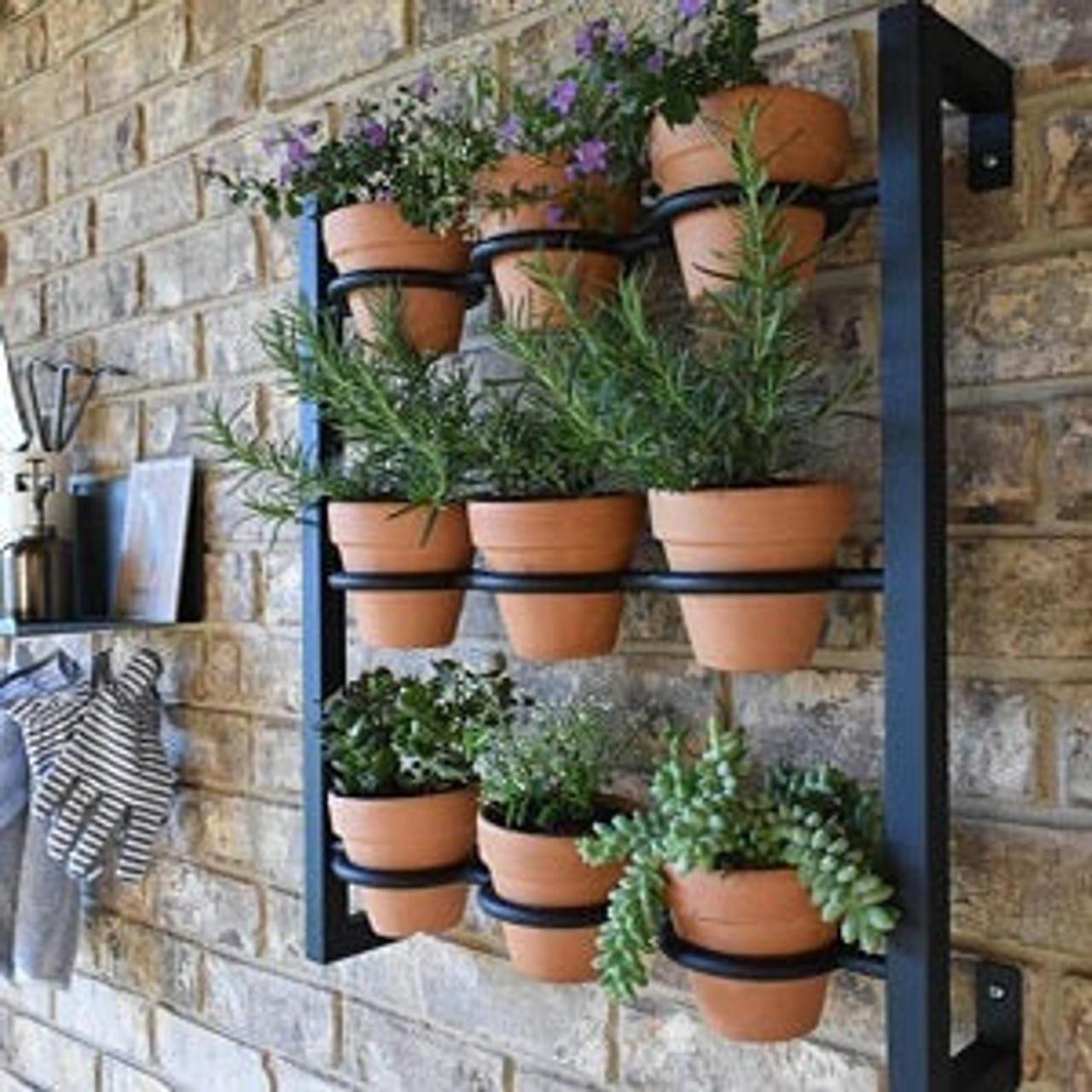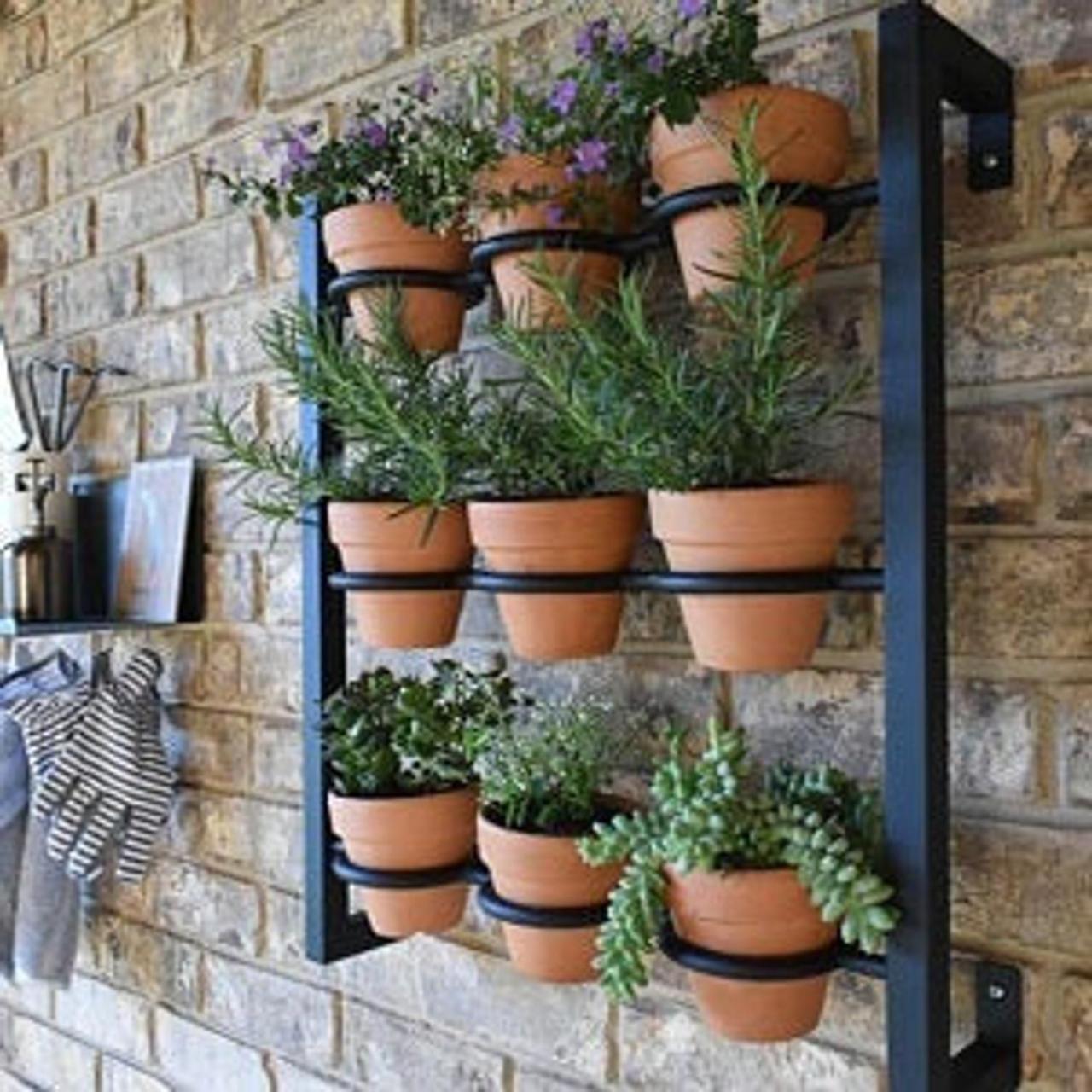How to Create a DIY Hanging Herb Garden is more than just a gardening project; it’s an invitation to transform your living space into a fragrant oasis. Imagine fresh herbs, plucked right from your own hanging garden, adding vibrant flavors to your meals.
With a little creativity and effort, you can create a stunning and functional herb garden that will enhance your culinary adventures and bring a touch of nature indoors.
This guide will walk you through every step of the process, from planning your garden to harvesting your herbs. We’ll cover everything from choosing the right containers and potting mix to planting, maintaining, and harvesting your herbs. Whether you’re a seasoned gardener or a beginner, this comprehensive guide will empower you to create a thriving hanging herb garden that will bring you joy for years to come.
Planning Your Hanging Herb Garden: How To Create A DIY Hanging Herb Garden
A hanging herb garden offers numerous advantages, including space-saving design, easy access to fresh herbs, and a visually appealing element to your home or garden. It’s an excellent choice for individuals with limited space, those seeking to add a touch of greenery to their living areas, or simply those who enjoy the convenience of having fresh herbs readily available.
Choosing Herbs for a Hanging Garden
When selecting herbs for your hanging garden, it’s crucial to consider factors such as their light requirements, growth habits, and intended uses.
- Light Requirements:Different herbs have varying sunlight needs. Some thrive in full sun, while others prefer partial shade. Ensure you choose herbs that will receive the appropriate amount of light in your hanging garden location.
- Growth Habits:Consider the size and shape of the herbs when selecting them. Some herbs grow tall and slender, while others spread out horizontally. Choose herbs that will fit comfortably within your hanging containers and complement each other.
- Desired Uses:Think about how you plan to use the herbs. If you primarily use them for cooking, select herbs with flavors that align with your culinary preferences. If you’re interested in their medicinal properties, choose herbs with known therapeutic benefits.
Suitable Herbs for Hanging Gardens
Here’s a list of herbs well-suited for hanging gardens, along with their specific needs and characteristics:
- Basil:A popular culinary herb that requires full sun and well-drained soil. It’s known for its sweet, pungent flavor and versatility in cooking.
- Chives:This herb prefers full sun to partial shade and thrives in well-drained soil. Chives have a mild onion flavor and are often used in salads, soups, and dips.
- Dill:Dill needs full sun and well-drained soil. It has a delicate, anise-like flavor and is commonly used in pickles, fish dishes, and salads.
- Mint:Mint is a fast-growing herb that prefers partial shade and moist soil. It has a refreshing, cool flavor and is used in teas, desserts, and cocktails.
- Oregano:Oregano thrives in full sun and well-drained soil. It has a strong, earthy flavor and is a staple in Italian and Mediterranean cuisine.
- Parsley:Parsley needs full sun to partial shade and well-drained soil. It has a fresh, bright flavor and is used as a garnish, in salads, and in soups.
- Rosemary:Rosemary prefers full sun and well-drained soil. It has a strong, piney flavor and is often used in roasted meats, soups, and sauces.
- Sage:Sage needs full sun and well-drained soil. It has a savory, slightly bitter flavor and is used in stuffing, poultry dishes, and sauces.
- Thyme:Thyme thrives in full sun and well-drained soil. It has a pungent, earthy flavor and is used in soups, stews, and roasted vegetables.
Designing Your Hanging Herb Garden
When designing your hanging herb garden, consider the size, shape, and placement of the containers.
- Size:Choose containers that are large enough to accommodate the herbs’ root systems and provide adequate drainage.
- Shape:Consider using containers that are sturdy and have a wide base to provide stability. Round, square, or rectangular containers are all suitable options.
- Placement:Select a location that receives the appropriate amount of sunlight for your chosen herbs. Ensure the hanging containers are secure and won’t be damaged by wind or rain.
Choosing the Right Containers

Selecting the right hanging planters is crucial for the success of your herb garden. The type of container you choose will impact drainage, water retention, and the overall health of your herbs.
Types of Hanging Planters
Hanging planters come in a variety of materials, each with its own advantages and disadvantages.
- Plastic:Plastic planters are lightweight, affordable, and come in a wide range of colors and styles. They are also durable and resistant to cracking. However, plastic can fade in sunlight and may not be as aesthetically pleasing as other materials.
- Terracotta:Terracotta planters are porous, allowing for good air circulation and drainage. They are also a classic and elegant choice. However, terracotta is prone to cracking, especially in extreme temperatures, and can become heavy when wet.
- Metal:Metal planters are durable and can withstand harsh weather conditions. They are also available in a variety of finishes, including galvanized steel, copper, and aluminum. However, metal can heat up quickly in the sun, potentially harming your herbs.
- Fabric:Fabric planters are lightweight and portable, making them ideal for hanging. They are also breathable, which helps to prevent root rot. However, fabric planters may require more frequent watering and can be susceptible to tearing.
Choosing the Right Size and Shape
The size and shape of your hanging planter should be chosen based on the type of herbs you are growing.
- Size:Herbs with shallow root systems, such as basil and oregano, can thrive in smaller planters. Herbs with deeper roots, such as rosemary and thyme, will need larger containers.
- Shape:Consider the growth habit of your herbs. For example, trailing herbs like mint or strawberries will do well in wider, shallower planters, while upright herbs like rosemary or sage will need taller containers.
Drainage
Proper drainage is essential for healthy herbs. Hanging planters should have drainage holes to prevent water from accumulating and causing root rot.
- Drainage Holes:If your planter does not have drainage holes, you can drill some yourself.
- Drainage Material:Place a layer of gravel or pebbles at the bottom of the planter to improve drainage. This will prevent the soil from becoming waterlogged.
Preparing the Planting Medium

The success of your hanging herb garden hinges on providing the right environment for your plants to thrive. One crucial element is the planting medium, which needs to be well-draining to prevent root rot and provide adequate aeration.
Creating a Homemade Potting Mix
A well-draining potting mix is essential for hanging herb gardens. Herbs, particularly those that prefer drier conditions, can be susceptible to root rot in overly wet soil. A homemade potting mix offers more control over the ingredients and ensures a balanced composition for optimal growth.
Here’s a recipe for a homemade potting mix ideal for herbs:
- Compost:Provides essential nutrients and improves soil structure.
- Coco Coir:Offers excellent water retention and aeration, promoting healthy root development.
- Vermicast:Adds beneficial microorganisms and enhances nutrient availability.
- Perlite:Improves drainage and aeration, preventing compaction.
Mix these ingredients in a ratio of 3:2:1:1 (compost: coco coir: vermicast: perlite) by volume. You can adjust the proportions based on the specific needs of your herbs. For example, herbs like rosemary and thyme may benefit from a slightly higher proportion of perlite for better drainage.
Adding Nutrients and Amendments
While the homemade potting mix provides a good foundation, additional amendments can further enhance its nutritional content and improve soil health.
- Compost:Incorporating compost into the potting mix provides a slow-release source of nutrients and improves soil structure, promoting better drainage and aeration.
- Fertilizer:A balanced, slow-release fertilizer can be added to the potting mix to provide essential nutrients for healthy growth. Opt for a fertilizer specifically formulated for herbs, as it will contain the appropriate ratios of nitrogen, phosphorus, and potassium. You can also use organic fertilizers like fish emulsion or compost tea to provide natural nutrients.
Filling the Hanging Planters
Once your potting mix is prepared, it’s time to fill the hanging planters. Leave approximately 2-3 inches of space at the top of the planter to allow for watering and prevent overflow. This space also ensures sufficient room for the roots to grow and develop.
- Water the Potting Mix:Before planting, thoroughly water the potting mix to ensure it’s evenly moistened. This helps to settle the mix and create a stable base for your plants.
- Plant the Herbs:Carefully place the herb seedlings or cuttings into the prepared potting mix. Make sure the roots are spread out and not cramped. Backfill with more potting mix, gently pressing it around the base of the plants.
Maintaining Your Hanging Herb Garden
A thriving hanging herb garden requires consistent care and attention. Regular maintenance ensures healthy growth, bountiful harvests, and a beautiful addition to your outdoor space. This section explores the essential tasks involved in maintaining your hanging herb garden, from watering to pest control.
Watering Your Hanging Herb Garden
The frequency and method of watering your hanging herb garden depend on factors such as climate, container type, and the specific herbs you’re growing. Here’s a guide to help you determine the best watering practices:
- Frequency:Water your hanging herb garden when the top inch of soil feels dry to the touch. In hot and dry climates, this may be daily, while in cooler and more humid regions, it might be every other day or even less often.
Creating a DIY hanging herb garden is a fantastic way to add a touch of greenery and fresh flavors to your home. When choosing herbs, it’s essential to consider the safety of your family, especially if you have young children or pets.
Refer to this comprehensive guide on Hanging Plants That Are Safe for Children and Pets for a list of non-toxic options. Once you’ve selected your safe herbs, you can create a beautiful and functional hanging garden that will bring joy and flavor to your home.
- Methods:Use a watering can with a fine rose to gently water the soil, avoiding over-watering. For larger containers, you can use a soaker hose or drip irrigation system to ensure even moisture distribution.
- Container Type:Terracotta pots tend to dry out faster than plastic containers, requiring more frequent watering. Consider using a pot with drainage holes to prevent overwatering and root rot.
Fertilizing Hanging Herbs
Regular fertilization is crucial for providing essential nutrients to your hanging herbs. However, over-fertilizing can damage the plants, so it’s essential to use the right amount and type of fertilizer.
- Frequency:Fertilize your hanging herbs every 2-4 weeks during the growing season.
- Types of Fertilizer:Use a balanced liquid fertilizer specifically designed for herbs, diluted according to the manufacturer’s instructions. Organic fertilizers, such as compost tea or fish emulsion, are also excellent options for promoting healthy growth.
- Over-Fertilizing:Signs of over-fertilizing include brown or yellowing leaves, stunted growth, and wilting. If you suspect over-fertilization, flush the soil with water to remove excess nutrients.
Pruning Hanging Herbs
Pruning your hanging herbs regularly promotes bushier growth, prevents legginess, and encourages more flowers and leaves.
- Pinching Back:Regularly pinch back the tips of your herbs to encourage branching and a fuller plant. This technique is especially effective for herbs like basil, mint, and oregano.
- Deadheading:Remove spent flowers to promote further blooming and prevent seed production, which can reduce the herb’s flavor.
- Harvesting:Harvesting your herbs regularly also acts as a form of pruning. This helps to maintain the plant’s shape and encourage new growth.
Pest Control in Hanging Herb Gardens
While herbs are generally pest-resistant, they can still be susceptible to common garden pests. Here are some tips for preventing and treating pests:
- Prevention:Choose pest-resistant herb varieties and ensure good air circulation around your hanging garden. Avoid overwatering, as this can attract pests.
- Common Pests:Aphids, whiteflies, spider mites, and slugs are common pests that can affect herbs.
- Treatment:For minor infestations, you can try handpicking pests or using a strong jet of water to dislodge them. For more severe infestations, consider using insecticidal soap or neem oil, which are safe for herbs and beneficial insects.
Harvesting and Enjoying Your Herbs

Your hanging herb garden is thriving, and now it’s time to reap the rewards of your hard work! Harvesting herbs at the optimal time ensures the best flavor and quality, allowing you to enjoy the fresh, aromatic bounty of your garden.
Harvesting Techniques, How to Create a DIY Hanging Herb Garden
The method you use to harvest your herbs depends on the specific type and its intended use. Here are some common techniques:
- Cutting Stems:For herbs like basil, rosemary, and thyme, cutting stems just above a leaf node encourages bushier growth and promotes new foliage. Cut stems in the morning after the dew has dried, as this minimizes the risk of wilting.
- Plucking Leaves:For herbs like mint and parsley, plucking individual leaves allows you to harvest only what you need without damaging the plant. Pinch off leaves from the top of the plant, leaving the lower leaves to continue growing.
- Harvesting Seeds:For herbs like dill, coriander, and fennel, harvest the seeds when they are fully mature and dry. Look for seeds that have turned brown and are easily removed from the plant.
Storing Fresh Herbs
Proper storage is crucial to preserve the flavor and freshness of your harvested herbs.
- Refrigeration:Most herbs can be stored in the refrigerator for up to a week. Wrap them loosely in paper towels or a damp cloth to prevent wilting. For longer storage, consider freezing herbs in ice cube trays with water or olive oil.
- Drying:Air drying is a common method for preserving herbs. Tie bundles of herbs together and hang them in a cool, dark, and well-ventilated area. Alternatively, use a food dehydrator for faster drying. Dried herbs can be stored in airtight containers in a cool, dark place for several months.
Creating a DIY hanging herb garden is a fantastic way to add greenery and fresh flavors to your home. To ensure your herbs thrive, it’s essential to choose the right fertilizer, especially since hanging plants have limited access to nutrients.
Best Fertilizers for Hanging Plants provides a comprehensive guide to help you select the perfect fertilizer for your herbs. Once you’ve got the right fertilizer, you can enjoy the benefits of a thriving, homegrown herb garden.
Using Fresh Herbs
The possibilities are endless when it comes to using fresh herbs in your culinary creations.
- Culinary Dishes:Add fresh herbs to soups, stews, sauces, salads, pasta dishes, and more. Use herbs to infuse oils, vinegars, and butter for added flavor.
- Beverages:Infuse fresh herbs into teas, cocktails, and lemonades. Mint, basil, and rosemary are popular choices for refreshing summer drinks.
- Other Applications:Use fresh herbs to make homemade soaps, bath salts, and potpourri. Incorporate herbs into your gardening routine by using them as natural pest repellents.
Epilogue
Creating a DIY hanging herb garden is a rewarding experience that brings the bounty of nature right to your doorstep. By following the steps Artikeld in this guide, you’ll be able to cultivate a vibrant and fragrant herb garden that will enhance your culinary creations and enrich your living space.
From choosing the right herbs and containers to maintaining your garden, every step is designed to ensure success. So, gather your tools, select your favorite herbs, and get ready to embark on a journey of gardening delight.
Frequently Asked Questions
What are the best herbs for a hanging garden?
Some of the best herbs for hanging gardens include basil, oregano, thyme, rosemary, and mint. These herbs are relatively easy to grow and thrive in containers.
How often should I water my hanging herb garden?
The frequency of watering depends on the climate and container type. Check the soil moisture regularly and water when the top inch of soil feels dry.
Can I use store-bought potting mix for my hanging herb garden?
Yes, but it’s recommended to amend it with compost or fertilizer to improve drainage and provide additional nutrients.
What should I do if my herbs are getting leggy?
Prune your herbs regularly to encourage bushier growth and prevent legginess. Pinch off the top growth points to promote side branching.
What are some tips for harvesting herbs from a hanging garden?
Harvest herbs in the morning after the dew has dried. Cut stems or pluck leaves, leaving some growth behind to encourage continued production.
